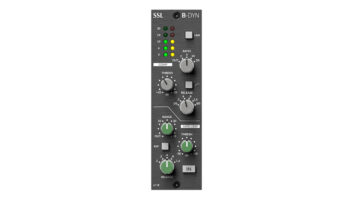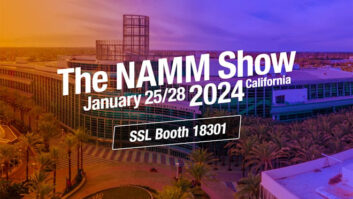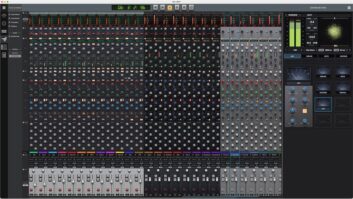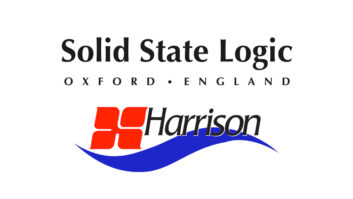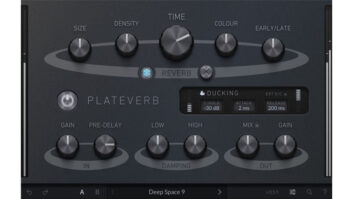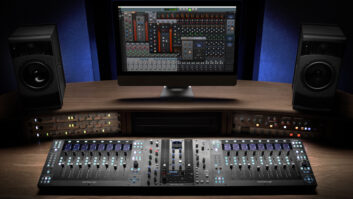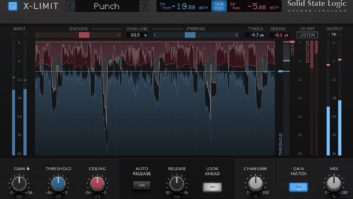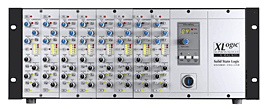
Most mortals can’t afford a Solid State Logic XL 9000 K Series console (a 48-channel frame is in the high six figures), but the same SuperAnalogue processing that board boasts is now available in a rackmountable, 4U powerhouse: the XLogic X-Rack. The X-Rack is a modular, powered system that can be fitted with up to eight SSL Dynamics, Mic Amp and Channel EQ modules — or blank panels as needed — in any combination. My review unit came with eight Model 729618X1 Dynamics modules installed.
All of the modules’ pots and switches can have their settings stored in Flash memory and recalled using SSL’s onboard Total Recall computer, which can be accessed via internal memory, MIDI or remote commands over 9-pin from a console such as the SSL AWS 900. Whether it is used in a stand-alone setup or patched to console inserts, the X-Rack makes the fabled SSL sound accessible for both studio and live applications.
I CAN RECALL
X-Rack’s central nervous system is its Total Recall computer, which stores and recalls 32 internal control setups. Total Recall’s front panel user interface comprises a combination rotary-and-push-switch control and three momentary switches used to save, overwrite, delete, recall and write-protect setups for all installed X-Rack modules. Setups can also be copied from one module to another or swapped between the two. Status LEDs and a large, numeric LED readout guide the user.
Total Recall uses status LEDs on all installed modules’ pots and switches to indicate whether or not they are set to the current setup’s stored values. LEDs labeled Sel at the top of each module flash when any of its control settings don’t match those for the current setup. Status LEDs for a module’s two-way switches light for those switches that need to be set to their alternate position to match the current setup. Bi-color status LEDs located above each rotary control knob light either green or red when an associated knob needs to be turned clockwise or counterclockwise, respectively, to restore the recalled settings. I found Total Recall to be an elegant, fast and intuitive solution for analog systems recall.
Nine-pin I/O connectors on the X-Rack’s rear panel can be used to daisychain up to three X-Racks together for connection to serial port 1 on an AWS 900 console. A 6-foot cable is supplied with each X-Rack for such purposes, and it can be extended up to 48 feet with a suitable extension cable; this allows the AWS 900’s Total Recall system to store and recall settings for connected X-Racks. The X-Rack also provides MIDI In and Out connectors for storing and recalling settings via System Exclusive bulk data dumps and loads, respectively, using any MIDI sequencer or DAW that implements Sys Ex.
Audio I/O connections vary for each module installed. World travelers will appreciate X-Rack’s auto-sensing power supply, which accommodates 90 to 264 volts. The detachable AC cord is securely held in place by a metal hinge — a nice touch.
IT’S DYNAMIC
The VCA-based compressor/limiter and expander/gate processors in the Dynamics module are simultaneously activated or bypassed using the same In switch. All rotary controls are continuously variable, and all switches latch (except for the Sel switch).
Rotary controls for the compressor/limiter section include those used for adjusting ratio (from 1:1 to :1), threshold and release time. Depressing the PK button changes the knee from soft to hard, and peak detection from RMS to peak-sensing for true limiter action. Attack time is program-dependent and varies from 3 to 30 ms, unless the Fast ATT switch is depressed; in which case, the attack time becomes fixed at 3 ms. Makeup gain is automatically applied, making setup (and A/B comparisons) a snap in most applications.
The expander/gate’s four wide-ranging rotary controls are used to adjust its range, threshold, and hold and release times. Activating an ENV switch changes the gating action to that of a 2:1 expander. Depressing this section’s separate Fast ATT button changes the attack time from 1.5 ms to 100 µsec for 40 dB of gain reduction — the maximum depth — in both cases.
Two five-segment LED ladders — one for the compressor/limiter and the other for the expander/gate — are provided to show the respective amount of gain reduction for each processing section. Depressing a Key switch routes signal received at the module’s rear panel key input (more on this later) to the sidechain used for both processors. Each module also features a Link button, which, when depressed, sums the control voltages for all linked modules so that the module with the greatest amount of gain reduction determines the depth of processing for all other linked modules.
Each Dynamics module’s rear panel includes separate XLRs for audio path and key inputs, and audio output. A latching switch sets nominal operating level for either +4 dBu or -10 dBV.
PROCESS THIS
My first tests of the Dynamics module was recording male lead and background vocals using an AKG C 12 VR mic. Light compression transparently smoothed the tracks’ dynamics and slightly mellowed the upper-midrange frequencies. This produced a silky sound that I liked for lead vocals, but didn’t find suitable where background vocals needed to cut.
On fiddle, the Fast Attack setting tamed unruly peaks that the program-dependent Attack couldn’t quite grab. Upper mids were softened slightly, which was flattering in this case. This timbral coloration also sounded awesome on an electric guitar track recorded with a Royer R-122 ribbon mic, yielding a flattering “brown” sound that nevertheless retained its crunchiness. Fast time constants and low ratio and threshold settings produced a tightly controlled, “in-your-face” assault.
Patching a kick drum track into the key input for a module that was processing a bass guitar’s audio signal, I triggered the gate (and compressor) so that the bass would only sound with kick hits. With fast attack and release times, the hold time determined how long the gate stayed open and set the groove. I could easily set the threshold to prevent snare drum bleed from opening the gate. In another bass guitar application, limiting using fast time constants lent a good dose of grunge to the bass that sounded really tough when combined with the original track.
On linked modules serving stereo drum room mics, maximum ratio, minimum threshold and fast release produced a suitably trashy sound with good attack — though not nearly as “spanked” as a Universal Audio 2-1176 gave. The Fast Attack setting clamped down too much on the traps’ attack and made cymbals pump too much, but switching out that control yielded great results.
Used as a mix bus compressor, the Dynamics module produced a punchy mix using program-dependent attack times and, alternatively, leveled drum hits and other transients using the Fast Attack setting. As the Fast Attack setting didn’t make the mix any louder, I preferred using the punchier program-dependent setting on the mix. Oddly, the linked modules’ meters showed different amounts of gain reduction from each other at times, although a headphone check confirmed that the stereo image remained rock-solid. And although the module’s maximum threshold is specified to be +10 dBu (fairly low for use on a hot console’s mix bus), I had to set it to -20 dBu to get noticeable gain reduction using the very low ratio suited for this application.
In comparison, my stereo-linked Aphex 651 Expressors (the discontinued, solid-state model) gave a slightly louder yet more dynamic, open and crisp sound. The SSL modules sounded fuller and warmer, and never got edgy or thin on screaming choruses that kept my meters topped.
THE BIG PICTURE
My few complaints about the Dynamics module are minor. The only way to bypass the effect of the compressor/limiter without bypassing the entire module is to set its ratio to 1:1; independently bypassing the expander/gate would require setting the range control fully counterclockwise. A key-listen circuit and output gain control are not offered; the latter omission can be inconvenient when you are feeding a downstream A/D, for example, where inputs may only offer hard-to-access trim controls for adjusting gain. Except for the 0dB marking for compressor threshold, only minimum and maximum settings for controls are noted on the faceplate. The meters should be more finely resolved toward the bottom end of their gain-reduction range, especially for use as a mix bus compressor. Last, the male XLR connectors for inputs don’t latch.
However, these negatives do not affect the Dynamics module’s sound, which is excellent. And Total Recall is a considerable asset for critical tracking, mixing and mastering sessions. Cost, on the other hand, is a major consideration. An “empty” X-Rack (powered and fitted with Total Recall) lists for $2,425 ($8,550 fully loaded), and any type of module individually costs $815. But if you can afford the scratch, you’ll be happy with your investment.
Solid State Logic, 212/315-1111, www.solid-state-logic.com.
Mix contributing editor Michael Cooper is the owner of Michael Cooper Recording.
